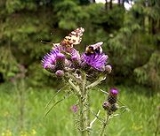
Cirsium palustre
Encyclopedia
Cirsium palustre, the marsh thistle or European swamp thistle, is a herbaceous biennial
(or often perennial
) species of the genus Cirsium
. It is a tall thistle
which reaches up to 2 metres (6.6 ft) in height. The strong stems have few branches and are covered in small spines. In its first year the plant grows as a dense rosette
, at first with narrow, entire leaves with spiny, dark purple edges; later, larger leaves are lobed. In the subsequent years the plant grows a tall, straight stem, the tip of which branches repeatedly, bearing a candelabra of dark purple flowers, 10–20 mm (0.393700787401575–0.78740157480315 in) with purple-tipped bract
s. In the northern hemisphere these are produced from June to September. The flowers are occasionally white, in which case the purple edges to the leaves are absent. It is native to Europe
where it is particularly common on damp ground such as marshes, wet fields, moorland and beside streams. In North America
it is an introduced species
that has become invasive
.
era or before. It is a constant plant of several fen-meadow
plant associations, including the Juncus subnodulosus-Cirsium palustre fen-meadow
.
Biennial plant
A biennial plant is a flowering plant that takes two years to complete its biological lifecycle. In the first year the plant grows leaves, stems, and roots , then it enters a period of dormancy over the colder months. Usually the stem remains very short and the leaves are low to the ground, forming...
(or often perennial
Perennial plant
A perennial plant or simply perennial is a plant that lives for more than two years. The term is often used to differentiate a plant from shorter lived annuals and biennials. The term is sometimes misused by commercial gardeners or horticulturalists to describe only herbaceous perennials...
) species of the genus Cirsium
Cirsium
Cirsium is a genus of perennial and biennial flowering plants in the Asteraceae, one of several genera known commonly as thistles. They are more accurately known as Plume thistles. These differ from other thistle genera in having feathered hairs to their achenes...
. It is a tall thistle
Thistle
Thistle is the common name of a group of flowering plants characterised by leaves with sharp prickles on the margins, mostly in the family Asteraceae. Prickles often occur all over the plant – on surfaces such as those of the stem and flat parts of leaves. These are an adaptation that protects the...
which reaches up to 2 metres (6.6 ft) in height. The strong stems have few branches and are covered in small spines. In its first year the plant grows as a dense rosette
Rosette (botany)
In botany, a rosette is a circular arrangement of leaves, with all the leaves at a single height.Though rosettes usually sit near the soil, their structure is an example of a modified stem.-Function:...
, at first with narrow, entire leaves with spiny, dark purple edges; later, larger leaves are lobed. In the subsequent years the plant grows a tall, straight stem, the tip of which branches repeatedly, bearing a candelabra of dark purple flowers, 10–20 mm (0.393700787401575–0.78740157480315 in) with purple-tipped bract
Bract
In botany, a bract is a modified or specialized leaf, especially one associated with a reproductive structure such as a flower, inflorescence axis, or cone scale. Bracts are often different from foliage leaves. They may be smaller, larger, or of a different color, shape, or texture...
s. In the northern hemisphere these are produced from June to September. The flowers are occasionally white, in which case the purple edges to the leaves are absent. It is native to Europe
Europe
Europe is, by convention, one of the world's seven continents. Comprising the westernmost peninsula of Eurasia, Europe is generally 'divided' from Asia to its east by the watershed divides of the Ural and Caucasus Mountains, the Ural River, the Caspian and Black Seas, and the waterways connecting...
where it is particularly common on damp ground such as marshes, wet fields, moorland and beside streams. In North America
North America
North America is a continent wholly within the Northern Hemisphere and almost wholly within the Western Hemisphere. It is also considered a northern subcontinent of the Americas...
it is an introduced species
Introduced species
An introduced species — or neozoon, alien, exotic, non-indigenous, or non-native species, or simply an introduction, is a species living outside its indigenous or native distributional range, and has arrived in an ecosystem or plant community by human activity, either deliberate or accidental...
that has become invasive
Invasive species
"Invasive species", or invasive exotics, is a nomenclature term and categorization phrase used for flora and fauna, and for specific restoration-preservation processes in native habitats, with several definitions....
.
Ecology
C. palustre is broadly distributed throughout northern Europe and eastward to central Asia. This thistle's occurrence is linked to the spread of human agriculture from the mid-HoloceneHolocene
The Holocene is a geological epoch which began at the end of the Pleistocene and continues to the present. The Holocene is part of the Quaternary period. Its name comes from the Greek words and , meaning "entirely recent"...
era or before. It is a constant plant of several fen-meadow
Fen-meadow
A Fen-meadow is a habitat that occurs in numerous locations throughout northern and western Europe. This habitat is found in generally damp lowland areas....
plant associations, including the Juncus subnodulosus-Cirsium palustre fen-meadow
Juncus subnodulosus-Cirsium palustre fen-meadow
The Juncus subnodulosus-Cirsium palustre fen-meadow is a plant association characteristically found on damp ground in portions of western Europe...
.

